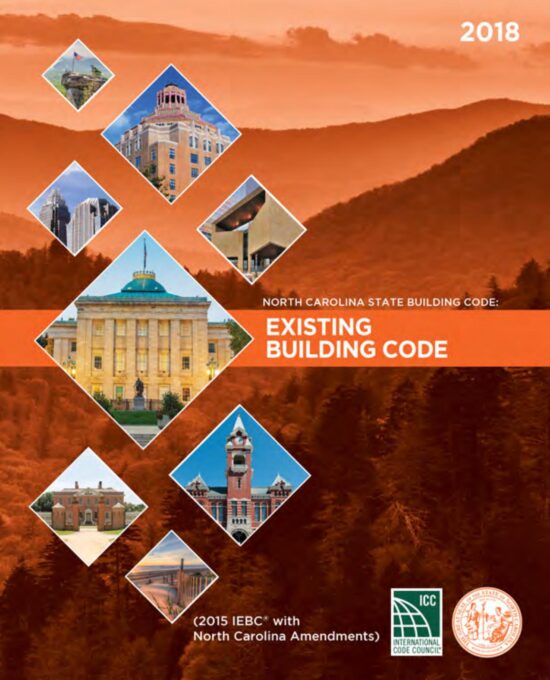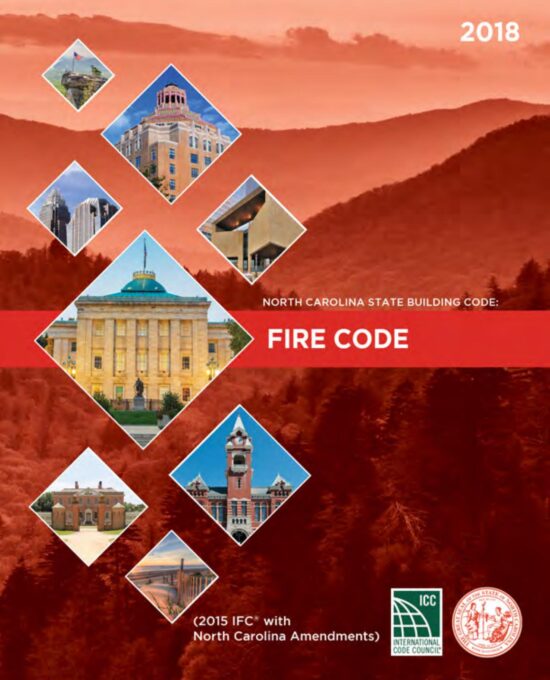2018 North Carolina State Building Code: Existing Building Code
- Integrates North Carolina amendments to the 2015 IEBC for localized enforcement
- Offers three compliance methods: Prescriptive, Work Area, and Performance-based
- Provides rules for repairs, Level 1–3 alterations, additions, historic buildings, and relocated structures
- Includes accessibility provisions and seismic retrofit guidelines
- Enables flexible design options while maintaining public safety
- Structured to align with other I-Codes for holistic code integration
- Applies to commercial, industrial, and multi-unit residential buildings undergoing rehabilitation
NCEBC-2018
2018 North Carolina State Building Code: Existing Building Code
- Integrates North Carolina amendments to the 2015 IEBC for localized enforcement
- Offers three compliance methods: Prescriptive, Work Area, and Performance-based
- Provides rules for repairs, Level 1–3 alterations, additions, historic buildings, and relocated structures
- Includes accessibility provisions and seismic retrofit guidelines
- Enables flexible design options while maintaining public safety
- Structured to align with other I-Codes for holistic code integration
- Applies to commercial, industrial, and multi-unit residential buildings undergoing rehabilitation
NCEBC-2018
2018 North Carolina State Building Code: Fire Code (NCFC)
The 2018 North Carolina State Building Code: Fire Code (NCFC) is a state-adopted adaptation of the 2015 International Fire Code®, enhanced with North Carolina-specific amendments. This code establishes minimum requirements to safeguard life, property, and public welfare from fire, explosion, and related hazards in all buildings and premises.
Designed for use by fire officials, code enforcers, architects, engineers, and contractors, the NCFC provides a comprehensive framework for fire prevention and protection systems. It ensures compliance through both prescriptive measures and performance-based design options applicable to new and existing structures.
Highlights:
- Integrates provisions from the 2015 International Fire Code® with North Carolina-specific modifications
- Addresses fire safety for construction, storage, occupancy use, and hazardous materials handling
- Regulates fire alarm systems, sprinklers, extinguishers, and egress pathways
- Enforces standards for emergency preparedness, fire command centers, and fire service access
- Includes clear rules for combustible storage, flammable finishes, and fuel dispensing systems
- Provides inspection, permitting, and enforcement protocols
- Covers special occupancies such as marinas, high-piled storage, and industrial operations
- Includes adoptable appendices on hydrant spacing, firefighter air systems, and hazardous materials
Who It’s For:
Fire marshals, building inspectors, design professionals, and public safety officials engaged in the development, renovation, or inspection of facilities in North Carolina. Ensures uniform fire code enforcement and enhances fire and life safety across the state.
NCFC-2018
2018 North Carolina State Building Code: Fire Code (NCFC)
The 2018 North Carolina State Building Code: Fire Code (NCFC) is a state-adopted adaptation of the 2015 International Fire Code®, enhanced with North Carolina-specific amendments. This code establishes minimum requirements to safeguard life, property, and public welfare from fire, explosion, and related hazards in all buildings and premises.
Designed for use by fire officials, code enforcers, architects, engineers, and contractors, the NCFC provides a comprehensive framework for fire prevention and protection systems. It ensures compliance through both prescriptive measures and performance-based design options applicable to new and existing structures.
Highlights:
- Integrates provisions from the 2015 International Fire Code® with North Carolina-specific modifications
- Addresses fire safety for construction, storage, occupancy use, and hazardous materials handling
- Regulates fire alarm systems, sprinklers, extinguishers, and egress pathways
- Enforces standards for emergency preparedness, fire command centers, and fire service access
- Includes clear rules for combustible storage, flammable finishes, and fuel dispensing systems
- Provides inspection, permitting, and enforcement protocols
- Covers special occupancies such as marinas, high-piled storage, and industrial operations
- Includes adoptable appendices on hydrant spacing, firefighter air systems, and hazardous materials
Who It’s For:
Fire marshals, building inspectors, design professionals, and public safety officials engaged in the development, renovation, or inspection of facilities in North Carolina. Ensures uniform fire code enforcement and enhances fire and life safety across the state.
NCFC-2018

